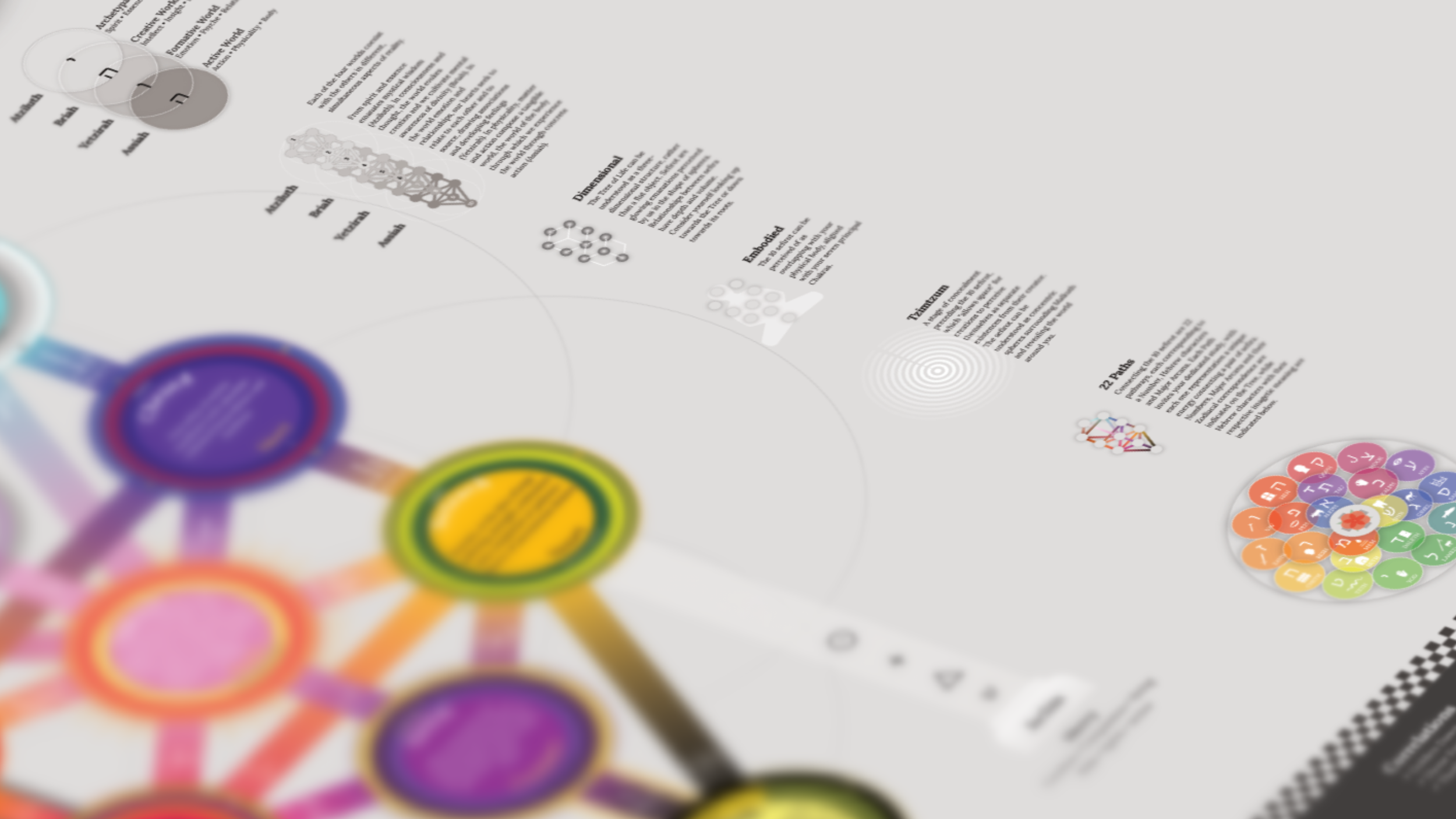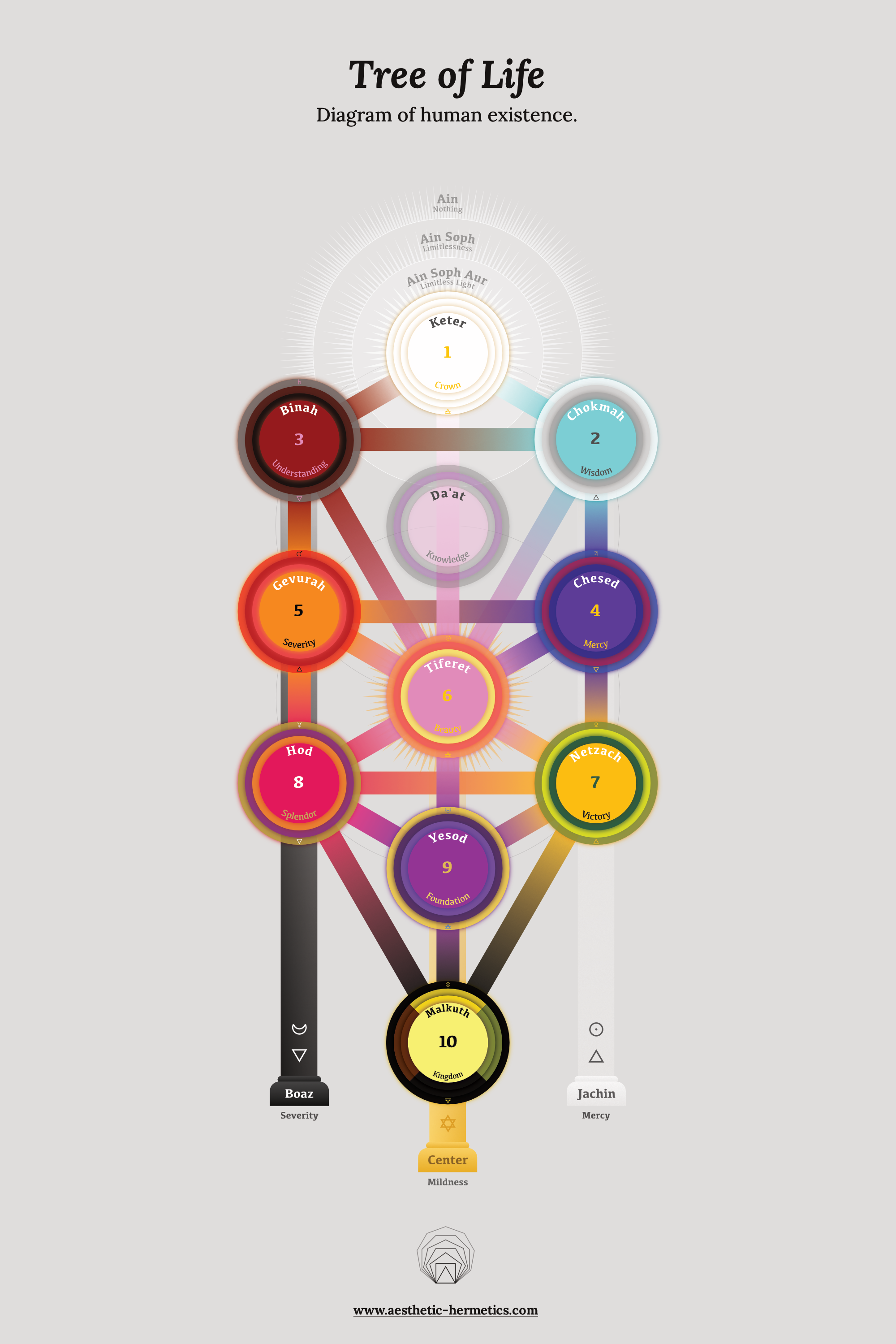Tree of Life
The Tree of Life is a diagram of human existence — a roadmap of mind, body and spirit and how they relate. The Tree represents a series of 10 divine emanations and how they interact to create our reality. Learning to interpret the Tree is about balancing the tension of opposites in your life and the world around you.
The Tree is also a symbolic glyph which embodies the magical axiom of “as above, so below", representing universe (macrocosm) and body (microcosm), each reflecting the other.
Finally the Tree is a map of the psyche, enabling you to explore your own mental and emotional landscapes with a well-used and effective map that is designed to facilitate growth and realization of the self.


Learn
The Tree of Life can be studied by anyone, regardless of religion, culture or language. Consider meditating on the Tree and its many aspects, in order to advance your initiation.
Ten Sefirot
Each sefira consists of a series of meanings and correspondences, including how they are defined and how they relate to each other. Different occult systems like alchemy and astrology help explain emanations from different perspectives.
Four Worlds
The 10 sefira exist in what are called the four worlds, or four states of being, from the most abstract and spiritual to the most dense and material. Each sefira emanates a different color in each world. From divine spirit, source steps toward creation through all four worlds.
Shop
Research
We have consolidated the information and correlations to present the Tree of Life from as many sources as possible.


Sources
- Bahir (Kaplan)
- History of Magic (Levi)
- Liber 777 (Crowley)
- Mystical Qabalah (Fortune)
- Secret Inner Order Rituals Of The Golden Dawn (Zalewski)
- Secret Wisdom of the Qabalah (Fuller)
- Sepher Yetzirah
- Three Books of Occult Philosophy (Agrippa)
- Wikipedia
- 22teachings.com
Correlations
- Golden Dawn (Paths)
- Dione Fortune (Colors)
- Thoth (Arcana)
How can I use the Tree of Life in daily life?
There are many ways that you can incorporate the principles and symbolism of the Kabbalistic Tree of Life into your daily life. Some ideas might include:
- Meditation: You can use the Tree of Life as a meditation guide, focusing on each sefirah in turn and contemplating its meaning and significance.
- Reflection: You can use the Tree of Life as a way of understanding yourself and your place in the world. Reflecting on the sefirot and their connections can help you to gain insights into your own thoughts, feelings, and actions.
- Creative expression: You can use the Tree of Life as a source of inspiration for artistic pursuits such as painting, drawing, or writing.
- Spirituality: You can use the Tree of Life as a way of connecting with your own spirituality and seeking a deeper understanding of the divine.
Overall, the Tree of Life can be a powerful tool for personal growth and self-discovery, and incorporating it into your daily life can help you to live a more meaningful and fulfilling life.
What is the origin of the Tree of Life?
The origins of the Kabbalistic Tree of Life are not entirely clear, as it is a symbol that has evolved over time and has been interpreted in different ways by different people. However, it is believed to have roots in Jewish mythology and spirituality, and it is closely associated with the Kabbalah, a mystical tradition within Judaism.
According to tradition, the Tree of Life was revealed to the ancient Israelites by God and was described in the Hebrew Bible in the book of Proverbs. The Tree of Life is also mentioned in the book of Genesis, where it is said to be located in the Garden of Eden. In the Kabbalah, the Tree of Life is seen as a map of the universe and a symbol of the relationship between God, the human soul, and the physical world.
The Tree of Life has also been adopted and interpreted by various spiritual and esoteric traditions outside of Judaism, and it has become a widely recognized and influential symbol in many different cultures.
Who is the Tree of Life for?
The Kabbalistic Tree of Life is a symbol and a tool that is used in the Kabbalah, a mystical tradition within Judaism. However, it is not exclusively for people of the Jewish faith, and many people from different spiritual backgrounds and traditions may find meaning and value in studying and working with the Tree of Life. The principles and symbolism contained within the Tree of Life are universal and can be applied to anyone's life, regardless of their religious or spiritual background. Ultimately, the Tree of Life is a tool for personal growth and self-discovery, and anyone who is seeking a deeper understanding of themselves, the world, and the divine may find it to be a useful and meaningful resource.


